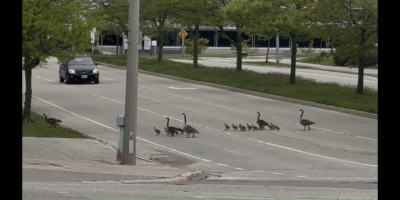The oldest recorded discussion of Orientation Week at the University of Waterloo is from the October 13, 1961 edition of The Coryphaeus, the University of Waterloo’s first student newspaper. It’s a simple article that welcomes freshman engineers to the school and the Engineering Society. It also gives thanks to Dave Smith, chairman of the Initiation Committee (Orientation used to be called initiation) and announces the Initiation Dance as part of WA-WA-WEE ’61 (The old name of Warrior Weekends, an event that rab up to 2011).
The September 27, 1963 edition of The Coryphaeus gives even more details on “initiation” with an article discussing the school-wide scavenger hunt (apparently they acquired things like wagons, tractors, hay bales, snow fences and pictures of someone named Brigitte Bardot), a game to measure the length of a city block with hotdogs, a challenge to make a line of pennies stretching from Kitchener City Hall to Waterloo City Hall (which is apparently approximately 140,000 pennies), the (seemingly) annual ‘Froshman Hop’ dance, and some unknown event called the ‘Hootenanny’. Each faculty organized their own Initiation program and worked with the Orientation Committee, which ensured the individual programs worked across the school.
In ’64, ’65, and ’66 even more traditions had started to form. First year students from Arts, Science and Engineering (the only faculties at UW at the time) were all awarded ‘beanies’ or caps at the beginning of (the now called) Orientation and the cheer of “I’m a dirty rotten dead horse and I stink!” was used throughout the week, accompanied by students falling to the ground, laying on their back and sticking their arms and legs in the air. The Frosh Queen competition, in which ‘Freshettes’, or female first-year students, competed to be elected to the position complete with sash and crown, became a major event. The penny-drive also became Slave Day, where first-year students would be sold to members of the community to help them with whatever they choose, or for charity purposes.
In 1967, Stewart Saxe, a political science student and head of the Orientation Committee, re-imagined the entire week and introduced the big-brother concept. All first year students (there were only 2,200 in 1967, a third of the 6,000+ we expect this year) were divided into groups of ten which were overseen by Archons, a single upper-year student leader, which stayed with the group the entire week. This year continued the method of each society running their initiation programs, and the Orientation Committee overseeing the entire thing.
1967 was also the first year that an aerial photo from Orientation Week was published. The 360 strong group spelled “Hagey” across the Arts quad to salute then-president J. G. Hagey (the same Hagey that Hagey Hall is named after).
It was during the late 1960s that the bulk of Orientation Week was moved to the control of the Federation of Students (FEDS). While the student societies still planned and ran programming for their specific faculty, many of the larger events would be planned by FEDS. It’s from this point throughout the 1970s that FEDS took the Orientation Week of the 1960s and made it into a month long Orientation program with varied social or educational events each day from the start of September to the end. This included many high-profile concerts such as Meatloaf, Gordon Lightfoot and Ike and Tina Turner, as well as speeches from major political figures, cabinet ministers, MPPs and radical leaders.
While the much expanded programming offered more choices for incoming students, it was during this time that student apathy and low attendance began to take its toll. Concerts lost money (the Ike and Tina Turner concert lost $6,000 in 1972, which is over $30,000 today accounting for inflation), speeches went unattended and acts cancelled or simply didn’t show. Reviews of the Orientation program varied wildly from condemnation to enthusiastic.
It was during this time that the Engineering Orientation program moved away from the Slave Day charity and began running the Bus Push charity (which has continued annually since then in the Winter term). 1969 also saw the Engineering Stag event of Orientation Week, which was little more than a drunken strip-tease for first-year students.
It wasn’t until 1978, when the LLBO took dispute with the University’s ‘beer tents’ that programming needed to be reduced and concerts rethought. The LLBO refused to license the outdoor tents that were part of Orientation Week in years past, reducing the amount of money that the Orientation program had to use, preventing headline concert acts and major guests.
Then began the dark years (or the years where written records become spotty). It’s expected that Orientation Week continued this way for the 1980s and early 1990s. Student societies continued running programming for their faculties, and the Federation of Students continued running the overall program. It was during an unknown Orientation Week during the 1980s that the Education Committee was founded, and that the engineering hardhats became a major symbol. These have stayed as key components of Engineering Orientation Week since then. The oldest record of the Education Committee is an Orientation Week video from 1988 and hardhats could be over a decade older than that.
At the end of the dark years, Engineering Orientation Week was a tight, multi-day program packed with events. Incoming students would go through a program similar to the program we have now, but that had very distinct differences. In 1993 a UW Orientation Manual was produced and distributed to the groups running the faculty programming and soon after a major part of Orientation Week today was founded; the Federation Orientation Committee (FOC). The goal with FOC was to have better collaboration between the independent groups running various Orientation Week programming and the Federation of Students, allowing a more efficient Orientation Week overall. This started the process of Orientation Week becoming more regulated and controlled, something that would take the unorganized month-long Orientation programs of the late ’70s and ’80s, to the smaller, week-long programs of the ’90s. By 1996, a schedule that resembles the modern day Engineering Orientation Week began to emerge: Aerial photos were taken (these can all be seen in the POETS lounge), they earned their hardhats, and they all met the Dean. However, they also competed in chariot races, paraded through town and had organized off-campus parties, events long since banned or modified.
It was during 1997 and 1998 that a new program started to address major concerns highlighted in an Orientation Student Survey conducted in 1994 and 1995. This survey concluded that there was a dangerous undercurrent of behavior across all Orientation programs. From discriminatory chanting to exclusive programming and a dependence on drinking, it was seen that there was a fundamental problem with Orientation Week; the leaders themselves. There was no formalized Orientation Leader training program for leaders to go through, and there were few checks and balances on the actions of these leaders too. People simply ran Orientation Week like it had been run for the year they went through it and every year before that.
It was because of this that the Provost’s Advisory Committee on Orientation (PACO) was founded, and PACO training was implemented in 1998. This training, mandatory for all Orientation leaders, covered things like drinking and drugs, inclusivity and non-discrimination. While some students cried out that this was gutting the Orientation Week they knew and loved, it ultimately led to the modern Orientation Week we have now, which many believe to be better than ever before.
With the double cohort of 2003, a large percentage of students were now entering university at age 18; younger than the legal drinking age. This became a problem as many planned events during Orientation Week were ‘wet’ events where alcohol was served. A controlled environment was implemented, with ‘beer gardens’ allowed at certain events and each organizing group allowed to have a single ‘wet’ event for their faculty or residence.
By 2004, PACO was dissolved and we were left with Orientation Leader Training, the modern version of PACO leader training. 2004 was also the last year that Orientation Week officially included alcohol with a beer garden at the Saturday night Toga party. Once Orientation Week 2004 closed, alcohol wouldn’t be part of the week again.
In 2012, Orientation Week is over 50 years old, involves over 8,000 first-year students, 1,000 upper year students, has a budget in the hundreds of thousands, and the support of countless sponsors and contributors. While it may be completely different from the Initiation of 1961, Orientation Week 2012 has built upon the past decades; all of the conflicts and problems, changes, successes and failures have been rolled into the week.
While it may not be perfect, it is a continuation of a tradition started soon after the University of Waterloo was founded, and it represents the unconventional history and future of this school.
(Editor’s note: Some minor modifications made to the original article by Ross to keep the article current.)




Leave a Reply